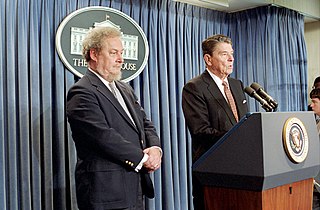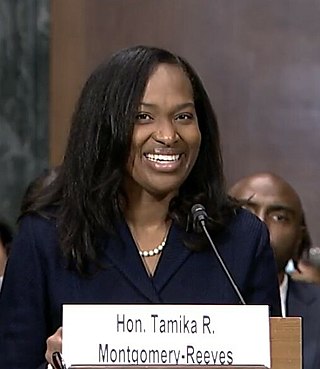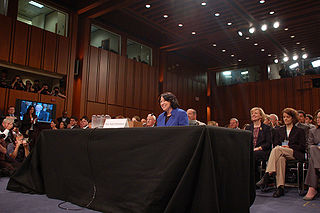
Sherman "Shay" Minton was an American politician and jurist who served as a U.S. senator from Indiana and later became an associate justice of the Supreme Court of the United States; he was a member of the Democratic Party.

Speculation abounded over potential nominations to the Supreme Court of the United States by President George W. Bush since before his presidency.

On July 1, 1987, President Ronald Reagan nominated Judge Robert Bork for Associate Justice of the Supreme Court of the United States, to succeed Lewis F. Powell Jr., who had earlier announced his retirement. At the time of his nomination, Bork was a judge on the United States Court of Appeals for the District of Columbia Circuit, a position to which he had been appointed by President Reagan in 1982.
During his two terms in office, President Dwight D. Eisenhower nominated five members for the Supreme Court of the United States: Chief Justice Earl Warren, and Associate Justices John Marshall Harlan, William Brennan, Charles Evans Whittaker, and Potter Stewart. All were confirmed by the Senate.

During his two terms in office, President Harry S. Truman appointed four members of the Supreme Court of the United States: Chief Justice Fred M. Vinson, Associate Justice Harold Burton, Associate Justice Tom C. Clark, and Associate Justice Sherman Minton.
During his twelve years in office, President Franklin D. Roosevelt appointed eight new members of the Supreme Court of the United States: Associate Justices Hugo Black, Stanley F. Reed, Felix Frankfurter, William O. Douglas, Frank Murphy, James F. Byrnes, Robert H. Jackson, and Wiley Blount Rutledge. Additionally, he elevated sitting Justice Harlan F. Stone to chief justice. Roosevelt's nine nominations filled eight seats on the Supreme Court because Byrnes resigned while Roosevelt was still in office. Roosevelt nominated Rutledge to the seat vacated by Byrnes.

The nomination and confirmation of justices to the Supreme Court of the United States involves several steps, the framework for which is set forth in the United States Constitution. Specifically, Article II, Section 2, Clause 2, provides that the president of the United States nominates a justice and that the United States Senate provides advice and consent before the person is formally appointed to the Court. It also empowers a president to temporarily, under certain circumstances, fill a Supreme Court vacancy by means of a recess appointment. The Constitution does not set any qualifications for service as a justice, thus the president may nominate any individual to serve on the Court.

Lucy Haeran Koh is an American lawyer and jurist serving as a U.S. circuit judge of the U.S. Court of Appeals for the Ninth Circuit. She is the first Korean American woman to serve on a federal appellate court in the United States. Koh previously served as a U.S. district judge of the U.S. District Court for the Northern District of California from 2010 to 2021. She also served as a California state court judge of the Santa Clara County Superior Court from 2008 to 2010.
U.S. President Barack Obama nominated over 400 individuals for federal judgeships during his presidency. Of these nominations, Congress confirmed 329 judgeships, 173 during the 111th & 112th Congresses and 156 during the 113th and 114th Congresses.

Beth Robinson is an American lawyer and judge from Vermont. She is a United States circuit judge of the United States Court of Appeals for the Second Circuit and is the first openly lesbian judge to serve on any Circuit Court. Robinson served as an associate justice of the Vermont Supreme Court from 2011 to 2021.
Donald Trump, President of the United States from 2017 to 2021, entered office with a significant number of judicial vacancies, including a Supreme Court vacancy due to the death of Antonin Scalia in February 2016. During the first eight months of his presidency, he nominated approximately 50 judges, a significantly higher number than any other recent president had made by that point in his presidency. By June 24, 2020, 200 of his Article III nominees had been confirmed by the United States Senate. According to multiple media outlets, Trump significantly impacted the composition of the Supreme Court and lower courts during his tenure.

Tamika Renee Montgomery-Reeves is an American lawyer who serves as a United States circuit judge of the United States Court of Appeals for the Third Circuit. She previously served as a justice of the Delaware Supreme Court.

On September 26, 2020, President Donald Trump announced the nomination of Amy Coney Barrett to the position of Associate Justice of the Supreme Court of the United States to fill in the vacancy left by the death of Ruth Bader Ginsburg. At the time of her nomination, Barrett was a Judge of the United States Court of Appeals for the Seventh Circuit in Chicago, Illinois. The Senate received word from the president on September 29.
President Joe Biden began his presidency with fewer vacancies to fill than his predecessor. President Biden pledged to nominate people with diverse backgrounds and professional experience. Biden also pledged to nominate the first Black woman to the Supreme Court of the United States.

On February 25, 2022, President Joe Biden announced that he would nominate Ketanji Brown Jackson to the position of associate justice of the Supreme Court of the United States to fill the vacancy by Stephen Breyer, who announced his retirement on January 27, 2022, at the age of 83. Jackson, a former law clerk of Breyer, was a judge on the United States Court of Appeals for the District of Columbia Circuit, having been appointed by Biden in 2021. Jackson is the first Black woman in U.S. history to be nominated to serve on the U.S. Supreme Court.

Harlan F. Stone was nominated and confirmed twice to the Supreme Court of the United States. First in 1925, when President Calvin Coolidge nominated him to serve as an associate justice and again in 1941, when President Franklin D. Roosevelt nominated Justice Stone to be elevated to Chief Justice. Both times, the United States Senate confirmed the nominations.

Louis Brandeis was nominated to serve as an associate justice of the Supreme Court of the United States by U.S. President Woodrow Wilson on January 28, 1916, after the death in office of Joseph Rucker Lamar created a vacancy on the Supreme Court. Per the Constitution of the United States, Brandeis' nomination was subject to the advice and consent of the United States Senate, which holds the determinant power to confirm or reject nominations to the U.S. Supreme Court.

Wiley Rutledge was nominated to serve as an associate justice of the Supreme Court of the United States by U.S. President Franklin D. Roosevelt on January 11, 1943, after the resignation of James F. Byrnes created a vacancy on the court. Per the Constitution of the United States, Rutledge's nomination was subject to the advice and consent of the United States Senate, which holds the determinant power to confirm or reject nominations to the U.S. Supreme Court. After being favorably reported on by both a subcommittee of the Senate Committee on the Judiciary and the full Judiciary Committee, the nomination was confirmed by the full Senate through a voice vote on February 8, 1943.

Thurgood Marshall was nominated to serve as an associate justice of the Supreme Court of the United States by U.S. President Lyndon B. Johnson on June 13, 1967 to fill the seat being vacated by Tom C. Clark. Per the Constitution of the United States, the nomination was subject to the advice and consent of the United States Senate, which holds the determinant power to confirm or reject nominations to the U.S. Supreme Court. Marshall was confirmed by the U.S. Senate in a 69–11 vote on August 30, 1967, becoming the first African American member of the Court, and the court's first non-white justice.

Since the creation of the Senate Committee on the Judiciary in 1816, many, but not all, nominations for the Supreme Court of the United States have been first referred to a committee for review prior to facing a confirmation vote before the full United States Senate. Some nominations have been withdrawn, lapsed, or been postponed without being referred to the Judiciary Committee, while some others up until 1941 had proceeded to full Senate confirmation votes without first being reviewed by the Judiciary Committee. However, ever since 1941, all nominations have been referred to the Judiciary Committee.




















